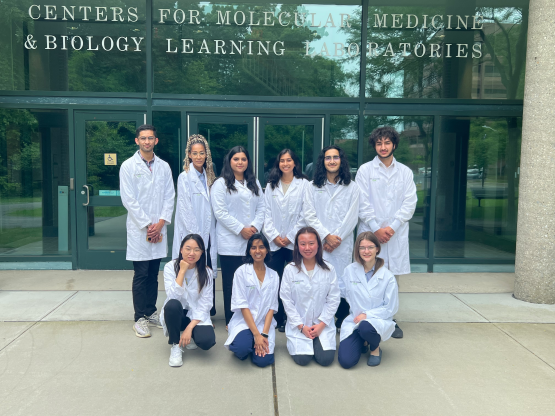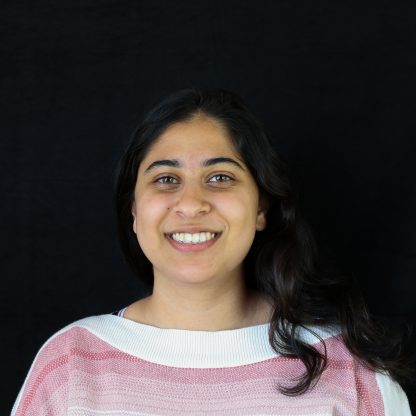
Many people tend to think of the quintessential college student as an 18-to-22 year-old who lives on campus and attends classes full time. They attend football games and frat parties and are excited for what are supposed to be the best four years of their life.
But in reality, nearly 40% of undergraduate students are older than 24, 58% are working while attending college and more than 25% are parents.
These students are non-traditional students. According to the National Center for Education Statistics, non-traditional students are typically considered to be over the age of 24.
One such student, Stephanie Laderwager, is a 34-year-old undergraduate at Stony Brook who is studying biology and hoping to earn her PhD in the future.
I met Laderwager through Stony Brook’s iGEM (International Genetically Engineered Machine) team, a student-led research group that competes in the largest synthetic biology competition in the world.
Every year for the past nine years, Stony Brook has had an iGEM team, competing against over 300 other universities from around the globe.
I worked closely with Laderwager for months on the Stony Brook 2022 team. We spent hours in the lab poring over research papers, reaching out to government agencies, hospitals, scientists and healthcare workers, and writing and solving dozens of mathematical equations.
Every day, Laderwager would be one of the first people in the lab and one of the last to leave. I watched her juggle her responsibilities as a mother, wife, student and iGEM team member. No one would have blamed her for slacking off or missing a few days of work.
But she never did.
So, when I found out that Laderwager would not receive proper credit for all the work she did for iGEM because of her standing as a non-traditional student, I was appalled.
On Sept. 30, only four weeks before the iGEM competition officially began on Oct. 26, Laderwager, the other nine undergraduate students on the team and I were informed that we would not be permitted to compete at the undergraduate level of the competition.
According to a spokesperson for iGEM headquarters, we were “obliged to compete in the Overgraduate section. If any team has a student member or leader above the age of 23 on 31 March 2022, then they are automatically assigned to the Overgrad section.” This is a policy that has been in place since 2013.
This came as a shock to us. After spending hundreds of hours in the lab, participating in local community initiatives and perfecting our project website and presentation, we were being told we had to compete against students with much higher degrees — solely because one of our members was a non-traditional student.
In order to do well in the iGEM competition, teams integrate inclusivity initiatives into their projects. Many of our team’s initiatives were aimed towards non-traditional students.
This was the first time any team in the competition had specifically sought to address these students through their project. This is not surprising as non-traditional students are a typically overlooked demographic in colleges and universities.
Our team conducted a full analysis of the various barriers that non-traditional students face, including balancing school, work, family commitments and/or financial obligations. We also conducted comprehensive research to see which institutions offer the most support for non-traditional students, and what aspects of their programs can be brought to Stony Brook.
In response to our findings, we explored the idea of creating a bridge research program between Stony Brook and Suffolk County Community College, a two-year institution only 20 minutes away that has a large population of non-traditional students.
Although the program has not been finalized, this comprised a large portion of our team’s inclusivity work, detailed on our competition website. This work helped us to receive a gold medal in the competition.
Stony Brook had not won a gold medal since 2018, and the change in fortune this year can be largely attributed to Laderwager.
It is ironic, therefore, that although we were applauded for our inclusivity efforts with non-traditional students, due to the presence of such a student on our team, we were not allowed to participate as undergraduates.
After hearing from the iGEM headquarters, John Gergen, the head of undergraduate biology at Stony Brook and the advisor of the iGEM team, wrote to the competition about the lack of inclusivity in their policy.
In response, we were given an ultimatum.
We could allow Laderwager to remain on the team roster as a member, and agree to participate in the overgraduate section. Or, we could remove her from the roster and compete as undergraduates.
Because she felt as though she would be a burden to the team as a result of this policy, Laderwager made the decision to be designated as an advisor for the project, getting removed from the roster and allowing us to compete as undergraduates.
Because of this, she was not considered a team member and could not compete or present at the international competition, despite having done so much work for the project. Future Stony Brook iGEM teams will also have to be more cautious in how they incorporate non-traditional students in the future.
However, this is but one example of many barriers that prevent non-traditional students from pursuing opportunities in STEM, and in academia more generally.
In 2014, there were over 1,400 students at Stony Brook who were over 24 years of age. Now, eight years later, that number has risen to over 7,100.
According to the Center for Postsecondary and Economic Success, 40% of the current undergraduate population at American colleges and universities are non-traditional. Throughout the United States, the non-traditional student population is growing rapidly, even up to twice as fast as the traditional student population.
However, according to the NASPA Research and Policy Institute Vice President of Student Affairs Census, only 58% of institutions offer support services to non-traditional students, as of 2014.
This means that most American institutions are failing to support their non-traditional students.
This presents a contradiction. If higher education truly aims to serve as a ladder to financial independence and a rewarding career, then why aren’t the current programs welcoming and accessible to students from all backgrounds?
Although non-traditional students lack support and are often overlooked, they are an inarguable asset for any institution. Not only do they offer a unique perspective and mindset, but they also create a better learning environment.
Various research studies have demonstrated that when non-traditional students are supported in their studies, they are more likely to persist, engage and contribute in the classroom. These interactions increase the breadth and quality of education for all students.
Laderwager was an immense asset to the team, and was critical to our success. Her contributions were numerous and helped bring our project to new heights. Neither her age nor her life circumstances prevented her from helping the team. In fact, I would argue that they made her more valuable as a member, allowing her to bring fresh insights and a new perspective.
Non-traditional students like Laderwager are not only critical for the future of higher education, but also the economy.
It is predicted that between 2023-2024 there will be fewer graduates than in 2011-2012, and that, from 2027-2032, the annual high school graduate population will be smaller than in 2013.
Consequently, this will impact the workforce and economy. Lower numbers of high school graduates will automatically result in fewer traditional college students, ultimately leading to a shortage of qualified and educated workers. Currently, 64% of jobs are projected to require higher education.
As a result, the Georgetown Center on Education and the Workforce predicted that the United States will be short 5 million workers with higher education degrees.
Non-traditional college students will help fill that gap. However, their impact extends beyond expanding the workforce. For example, the more highly educated a population is, the stronger the tax base will be. According to a report by the College Board, four-year college graduates pay an estimated 82% more in taxes.
Beyond financial gain, non-traditional students can also significantly impact their social and civic environments. College graduates have been found to be more likely to vote, volunteer and be involved in their community.
In this way, non-traditional students are critical to the success of higher education and the economy. They represent a crucial portion of the population with the potential to play a significant role in the betterment of society.
In general, the overall goal of higher education is to create a holistic, informing and engaging experience for students. Degrees should be accessible, not difficult, to attain. To accomplish this, services for non-traditional students must be provided and extend beyond the classroom.
It is unacceptable that non-traditional students often do not feel welcome or incorporated into the colleges and universities they attend. It is also appalling that pursuing higher education is difficult for them, especially when institutions have the power to change this and meet their needs.
It is not in the best interest of academia to impose barriers that prevent non-traditional students from pursuing careers in emerging, important and exciting areas.
Non-traditional students deserve equal opportunity and access to education. They should be encouraged and supported, not isolated and undermined. Not only do they deserve a higher education, but they significantly increase the quality of higher education . They are not the only ones who stand to lose from non-inclusive policies. Every student and institution suffers as a result.
Personally, I have learned so many things from a non-traditional student, and I am a better person for having met Laderwager.
Even if the iGEM competition does not recognize her efforts, I learned persistence, dedication and determination from her. Despite the fact that she is 15 years older than me, I made a friend who has taught me countless things both academically, but also personally.
I will always be grateful for the opportunity to have worked with Laderwager, and it is my sincere hope that more students like her will participate in iGEM and similar opportunities in the future.
However, in order for that to happen, there are a lot of changes that need to be made. Institutions need to become more proactive at supporting the needs of their non-traditional students.




















Karen Sterk • Nov 15, 2022 at 10:49 am
Kudos to you for calling out this important information! At the Jeannette Rankin Foundation, we provide Scholar Grants and support to women over the age of 35 nationally, who have financial need, for any post-secondary credential. We have an amazing Persistence Rate (continue or graduate) around 90% every year.